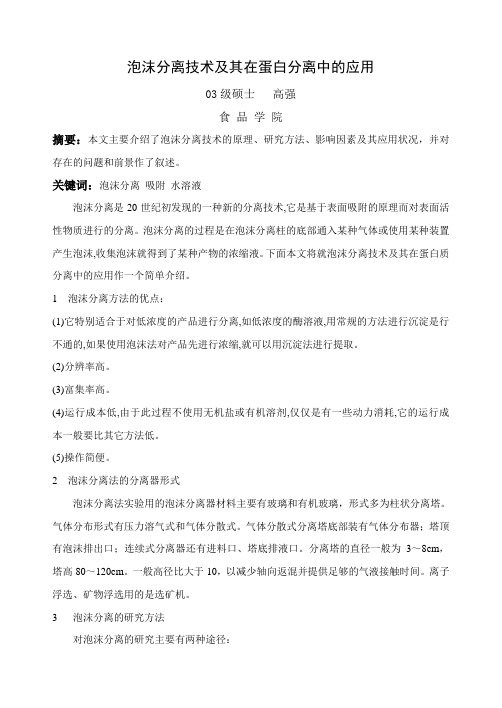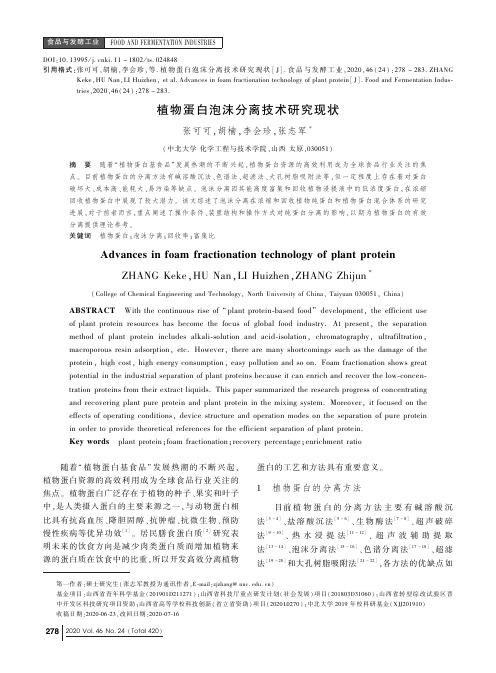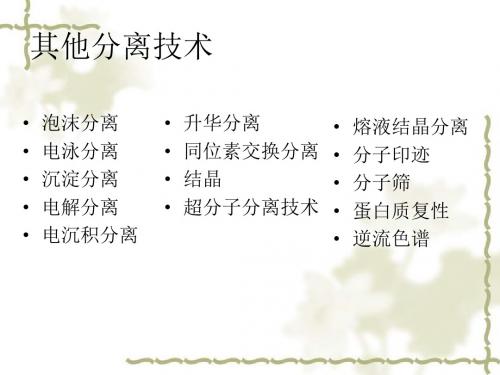泡沫分离法分离蛋白质
泡沫分离法

22
23
浓缩塔:表面活性剂的料液连续加入塔中的鼓泡 区,在塔顶设臵回流。将凝集的泡沫液部分引回 塔顶,以提高泡沫液的浓度即塔顶产品浓度,故 像精馏塔中的精馏段。除了外回流外,上升泡沫 中气泡聚集所形成的内回流同样具有提高塔顶产 品浓度的作用。但对残液的去污效果不好。 提取塔:料液从泡沫塔顶加入,这样的操作可以 达到很高的去污系数。故相当于提取塔。 复合塔:料液和部分表面活性剂由泡沫段底部加 入,塔顶也采用部分回流,故相当于复合塔。
泡沫分馏用于分离溶解物质,它们可以是表 面活性剂如洗涤剂,也可以是不具有表面活 性的物质如金属离子、阴离子、蛋白质、酶 等,但它们必须具有和某一类型的表面活性 剂结合的能力,当料液鼓泡时能进入液层上 方的泡沫层而与液相主体分离。由于它的操 作和设计在许多方面可与精馏相类比,所以 称它为泡沫分馏。
5
Γ为吸附溶质的表面过剩量,即单位面积上吸附溶质 的摩尔数与主体溶液浓度之差,对于稀溶液即为溶质 的表面浓度,可通过 σ (溶液的表面张力)与浓度c(溶 质在主体溶液中的平衡浓度)来求得;Γ/c为吸附分配 因子。 如果溶液中含离子 型表面活性剂,则
11
n为与离子型表面活性剂的类型有关的常数。例如为完 全电离的电解质类型n=2;在电解质类型溶液中还添 加过量无机盐时n=1。 溶液中表面活性剂浓度c和 表面过剩量Γ的相互关系可用 右图表示。在b点之前,随着 溶液中表面活性剂浓度c增加, Γ成直线增加:
20
A.间歇式泡沫分离过程 气体从塔底连续鼓 入,形成的泡沫液从塔 顶连续排出.原料液因 不断形成泡沫而减少, 可在塔的下部补充适当 表面活性剂,以弥补其 在分离过程产的减少。 间歇式操作可用于溶液 的净化和有用组分的回 收。见下图:
21
B.连续式泡沫分离过程 这种过程料液和表面活性剂连续加入塔 内,泡沫液和残液连续从塔内排出。 按照原料液引入塔的位臵不同,可将连 续泡沫分离分为浓缩塔(或称精馏塔)、提馏 塔和两者叠加的复合塔.可分别得到不同的 分离效果。见下图中(a)、(b)、(c)。
泡沫分离蛋白质

泡沫分离技术及其在蛋白分离中的应用03级硕士高强食品学院摘要:本文主要介绍了泡沫分离技术的原理、研究方法、影响因素及其应用状况,并对存在的问题和前景作了叙述。
关键词:泡沫分离吸附水溶液泡沫分离是20世纪初发现的一种新的分离技术,它是基于表面吸附的原理而对表面活性物质进行的分离。
泡沫分离的过程是在泡沫分离柱的底部通入某种气体或使用某种装置产生泡沫,收集泡沫就得到了某种产物的浓缩液。
下面本文将就泡沫分离技术及其在蛋白质分离中的应用作一个简单介绍。
1 泡沫分离方法的优点:(1)它特别适合于对低浓度的产品进行分离,如低浓度的酶溶液,用常规的方法进行沉淀是行不通的,如果使用泡沫法对产品先进行浓缩,就可以用沉淀法进行提取。
(2)分辨率高。
(3)富集率高。
(4)运行成本低,由于此过程不使用无机盐或有机溶剂,仅仅是有一些动力消耗,它的运行成本一般要比其它方法低。
(5)操作简便。
2 泡沫分离法的分离器形式泡沫分离法实验用的泡沫分离器材料主要有玻璃和有机玻璃,形式多为柱状分离塔。
气体分布形式有压力溶气式和气体分散式。
气体分散式分离塔底部装有气体分布器;塔顶有泡沫排出口;连续式分离器还有进料口、塔底排液口。
分离塔的直径一般为3~8cm,塔高80~120cm。
一般高径比大于10,以减少轴向返混并提供足够的气液接触时间。
离子浮选、矿物浮选用的是选矿机。
3 泡沫分离的研究方法对泡沫分离的研究主要有两种途径:3.1 分离条件实验主要研究对泡沫分离的影响因素,诸如:表面活性剂类型,浓度,pH,离子强度,气速,如果是连续分离方式还有进料浓度等。
3.2 分离器设计实验研究分离器的形式对分离的影响,要考虑进料口位置,鼓泡区高度,泡沫区高度,气体分布器孔径等。
对于蛋白质等生物大分子,它主要根据2个机理进行分离:(1)表面吸附机理,很多蛋白质分子具有较强的表面活性,它可以在泡沫的气液界面吸附。
(2)泡沫水分外排机理,即泡沫层中的泡沫上升过程中水分和蛋白质都会从泡沫中流出,但蛋白质的流出速度比水的流出速度要慢,这使得蛋白质在泡沫中富集,同时小泡沫之间的合并也促使水分流出,这也有利于蛋白质的富集。
第六章泡沫分离法

气泡借助浮力上升,冲击溶液 表面的单分子膜。
某些情况下,气泡可以跳出液体表面, 此时,该气泡表面的水膜外层上,形成 与液体内部单分子膜的分子排列完全相 反的单分子膜,从而构成了较为稳定的 双分子层气泡体,在气相空间形成接近 于球体的单个气泡。
许多气泡聚集成大小不同的球状 气泡集合体,更多的集合体聚集在一 起形成泡沫。
第六章 泡沫分离法
(Foam Separation)
泡沫分离技术(泡沫吸附分离技术)
➢ 1915年用于矿物浮选 ➢ 50年代用于分离金属离子的研究; ➢ 60年代采用泡沫分离法脱除洗涤剂工厂污水中
的表面活性剂获得成功; ➢ 1977年报道泡沫分离法用于DNA、蛋白质及
液体卵磷脂等生物活性物质的分离。
泡沫分馏用于分离溶解物质,它们可以 是表面活性剂,或者可与表面活性剂结合的 物质,当料液鼓泡时能进入液层上方的泡沫 层而与液相主体分离。
泡沫浮选用于分离不溶解的物质,按照 被分离对象是分子还是胶体,是大颗粒还是 小颗粒等,又可分为矿物浮选、粗粒浮选、 微粒浮选、离子浮选、分子浮选、沉淀浮选 和吸附胶体浮选。
形成泡沫的气泡集合体包括两个部 分:一是泡,两个或两个以上的气泡; 二是泡与泡之间以少量液体构成的隔 膜(液膜),是泡沫的骨架。
2.泡沫的稳定及层内排液
泡沫不是很稳定的体系,气泡与气 泡之间仅以薄膜隔开,此隔膜也会因彼 此压力不均或间隙流的流失等原因而发 生破裂,导致气泡间的合并现象;
由于小气泡的压力比大气泡高,因 此气体可以从小气泡通过液膜向大气泡 扩散,导致大气泡变大,小气泡消失。
表面活性剂的CMC一般在0.001~ 0.02mol/L左右,泡沫分离最好在低于CMC下 进行。
二.泡沫的形成与性质
蛋白质分离纯化的一般程序

蛋白质分离纯化的一般程序可分为以下几个步骤:(一)材料的预处理及细胞破碎分离提纯某一种蛋白质时,首先要把蛋白质从组织或细胞中释放出来并保持原来的天然状态,不丧失活性。
所以要采用适当的方法将组织和细胞破碎。
常用的破碎组织细胞的方法有: 1. 机械破碎法这种方法是利用机械力的剪切作用,使细胞破碎。
常用设备有,高速组织捣碎机、匀浆器、研钵等。
2. 渗透破碎法这种方法是在低渗条件使细胞溶胀而破碎。
3. 反复冻融法生物组织经冻结后,细胞内液结冰膨胀而使细胞胀破。
这种方法简单方便,但要注意那些对温度变化敏感的蛋白质不宜采用此法。
4. 超声波法使用超声波震荡器使细胞膜上所受张力不均而使细胞破碎。
5. 酶法如用溶菌酶破坏微生物细胞等。
(二) 蛋白质的抽提通常选择适当的缓冲液溶剂把蛋白质提取出来。
抽提所用缓冲液的pH、离子强度、组成成分等条件的选择应根据欲制备的蛋白质的性质而定。
如膜蛋白的抽提,抽提缓冲液中一般要加入表面活性剂(十二烷基磺酸钠、tritonX-100等),使膜结构破坏,利于蛋白质与膜分离。
在抽提过程中,应注意温度,避免剧烈搅拌等,以防止蛋白质的变性。
(三)蛋白质粗制品的获得选用适当的方法将所要的蛋白质与其它杂蛋白分离开来。
比较方便的有效方法是根据蛋白质溶解度的差异进行的分离。
常用的有下列几种方法:1. 等电点沉淀法不同蛋白质的等电点不同,可用等电点沉淀法使它们相互分离。
2. 盐析法不同蛋白质盐析所需要的盐饱和度不同,所以可通过调节盐浓度将目的蛋白沉淀析出。
被盐析沉淀下来的蛋白质仍保持其天然性质,并能再度溶解而不变性。
3. 有机溶剂沉淀法中性有机溶剂如乙醇、丙酮,它们的介电常数比水低。
能使大多数球状蛋白质在水溶液中的溶解度降低,进而从溶液中沉淀出来,因此可用来沉淀蛋白质。
此外,有机溶剂会破坏蛋白质表面的水化层,促使蛋白质分子变得不稳定而析出。
由于有机溶剂会使蛋白质变性,使用该法时,要注意在低温下操作,选择合适的有机溶剂浓度。
植物蛋白泡沫分离技术研究现状

278㊀2020Vol.46No.24(Total 420)DOI:10.13995/ki.11-1802/ts.024848引用格式:张可可,胡楠,李会珍,等.植物蛋白泡沫分离技术研究现状[J].食品与发酵工业,2020,46(24):278-283.ZHANGKeke,HU Nan,LI Huizhen,et al.Advances in foam fractionation technology of plant protein[J].Food and Fermentation Indus-tries,2020,46(24):278-283.植物蛋白泡沫分离技术研究现状张可可,胡楠,李会珍,张志军∗(中北大学化学工程与技术学院,山西太原,030051)摘㊀要㊀随着 植物蛋白基食品 发展热潮的不断兴起,植物蛋白资源的高效利用成为全球食品行业关注的焦点㊂目前植物蛋白的分离方法有碱溶酸沉法㊁色谱法㊁超滤法㊁大孔树脂吸附法等,但一定程度上存在着对蛋白破坏大㊁成本高㊁能耗大㊁易污染等缺点㊂泡沫分离因其能高度富集和回收植物浸提液中的低浓度蛋白,在浓缩回收植物蛋白中展现了较大潜力㊂该文综述了泡沫分离在浓缩和回收植物纯蛋白和植物蛋白混合体系的研究进展,对于前者而言,重点阐述了操作条件㊁装置结构和操作方式对纯蛋白分离的影响,以期为植物蛋白的有效分离提供理论参考㊂关键词㊀植物蛋白;泡沫分离;回收率;富集比Advances in foam fractionation technology of plant proteinZHANG Keke,HU Nan,LI Huizhen,ZHANG Zhijun ∗(College of Chemical Engineering and Technology,North University of China,Taiyuan 030051,China)ABSTRACT ㊀With the continuous rise of plant protein-based food development,the efficient use of plant protein resources has become the focus of global food industry.At present,the separation method of plant protein includes alkali-solution and acid-isolation,chromatography,ultrafiltration,macroporous resin adsorption,etc.However,there are many shortcomings such as the damage of the protein,high cost,high energy consumption,easy pollution and so on.Foam fractionation shows greatpotential in the industrial separation of plant proteins because it can enrich and recover the low-concen-tration proteins from their extract liquids.This paper summarized the research progress of concentrating and recovering plant pure protein and plant protein in the mixing system.Moreover,it focused on the effects of operating conditions,device structure and operation modes on the separation of pure protein in order to provide theoretical references for the efficient separation of plant protein.Key words ㊀plant protein;foam fractionation;recovery percentage;enrichment ratio第一作者:硕士研究生(张志军教授为通讯作者,E-mail:zjzhang@)㊀㊀基金项目:山西省青年科学基金(201901D211271);山西省科技厅重点研发计划(社会发展)项目(201803D31060);山西省转型综改试验区晋中开发区科技研究项目资助;山西省高等学校科技创新(省立省资助)项目(2020L0270);中北大学2019年校科研基金(XJJ201910)收稿日期:2020-06-23,改回日期:2020-07-16㊀㊀随着 植物蛋白基食品 发展热潮的不断兴起,植物蛋白资源的高效利用成为全球食品行业关注的焦点㊂植物蛋白广泛存在于植物的种子㊁果实和叶子中,是人类摄入蛋白的主要来源之一,与动物蛋白相比具有抗高血压㊁降胆固醇㊁抗肿瘤㊁抗微生物㊁预防慢性疾病等优异功效[1]㊂居民膳食蛋白质[2]研究表明未来的饮食方向是减少肉类蛋白质而增加植物来源的蛋白质在饮食中的比重,所以开发高效分离植物蛋白的工艺和方法具有重要意义㊂1㊀植物蛋白的分离方法目前植物蛋白的分离方法主要有碱溶酸沉法[3-4]㊁盐溶酸沉法[5-6]㊁生物酶法[7-8]㊁超声破碎法[9-10]㊁热水浸提法[11-12]㊁超声波辅助提取法[13-14]㊁泡沫分离法[15-16]㊁色谱分离法[17-18]㊁超滤法[19-20]和大孔树脂吸附法[21-22],各方法的优缺点如表1所示㊂其中,泡沫分离是一种利用气体为分离介质以达到分离和浓缩目的的新兴技术,针对植物浸提液中的低浓度蛋白质,该技术可实现其的高度富集和回收,降低其后续纯化和产品化难度;其次,泡沫分离设备简单,易于放大,操作条件温和,对蛋白质的活性影响小,因此在降低植物蛋白分离成本和保证蛋白功能性方面具有巨大潜力㊂本文将综述泡沫分离在浓缩回收植物蛋白质方面的应用情况,包括分离纯蛋白和蛋白混合体系工艺研究两方面㊂表1㊀植物蛋白质浓缩回收方法的汇总Table1㊀Summary of the methods for enriching and recovering plant protein提取方法优点缺点碱溶酸沉法工艺简单,提取率高,生产成本较低高温㊁强酸强碱条件易变性,蛋白色泽加深,消耗大量的酸和水,脱盐纯化难度大加酶提取法条件温和,减少水的消耗,保证蛋白质质量生产成本高超声波辅助提取法耗时短,蛋白提取率高影响蛋白质结构和功能热水浸提法成本较低,清洁,无污染营养物质破坏多色谱分离法快速准确,能够分离性质差别很小的化合物溶剂和固定相的选择较困难,洗脱时,容易造成溶剂浪费超滤法操作简单,条件温和,易于放大超滤膜容易污染,不能分离分子质量相近的蛋白大孔树脂吸附法吸附量大,选择性好,设备简单,操作方便,使用周期长,节省费用前处理复杂,使用前需要彻底去除致孔剂等有毒物质泡沫分离法设备简单,适用于低浓度的溶液,提取率高对高浓度的溶液分离效率较低盐溶酸沉法提取率高,不破坏蛋白灰分含量高,蛋白质溶解度低超声破碎法目标物质提取效果好,纯度高耗时耗能,提取率较低2㊀泡沫分离植物纯蛋白的研究进展2.1㊀工艺条件对泡沫分离植物蛋白的影响植物蛋白浸提液的溶液性质是影响其泡沫分离效果的重要因素,溶液初始浓度㊁温度[23]㊁离子浓度[24]和pH是研究者经常考察的关键因素,除此之外,进液量㊁气速㊁气体分布器孔径大小[23]和鼓泡时间[25]等操作条件同样不可忽视㊂(1)蛋白初始浓度㊂蛋白初始浓度通过影响溶液的表面张力影响泡沫起泡性,蛋白浓度越高表面张力越低,泡沫的发泡能力越强,排液速率越慢,回收率升高而富集比降低㊂为了形成稳定的泡沫层,蛋白质的浓度要在临界胶束浓度以下进行[26]㊂(2)pH值㊂pH值通过改变蛋白质的结构来影响蛋白质集聚,在pH等于等电点时,蛋白质所带静电荷为零,蛋白质分子周围的双电层消失,气泡表面液膜的厚度减小,泡沫排液速率加快,蛋白质分离效果最好[27]㊂李轩领[28]在提取亚麻籽蛋白时,富集比和回收率在其等电点pH等于3时达到最大㊂(3)进气速度㊂随着气速的增加,泡沫在分离柱内的时间缩短,减少了排水的时间所以富集比降低,泡沫量随之增加,使得回收率升高㊂(4)装液量㊂在泡沫分离过程中,装液量不同,其液相压力就不同,压力对气泡的大小和分布都有影响,分离效果随着液相压力的增大先明显增大,进而增加平缓,当压力增大到一定值,分离效果降低[29]㊂(5)温度㊂温度是影响液相吸附和泡沫相排液的因素之一,吸附是放热过程,而温度升高,则阻碍放热的进行,溶液的黏度随温度的升高而下降,有利于泡沫层排液[30]㊂(6)气体分布器㊂气体分布器孔径是控制气泡大小的重要因素,小的气泡有利于增大气液传质的比表面积,且在液相中上升的速度慢,有利于蛋白质的吸附,使得富集比增大[31]㊂(7)离子强度㊂增大离子强度可以改善蛋白在气-液界面处的吸附,提高排液,增加泡沫的稳定性,加大泡沫产量提高回收率㊂刘海滨[32]㊁刘颖[33]对桑叶㊁紫花苜蓿叶㊁菠菜叶以及亚麻籽㊁甘薯等蛋白浓缩和回收工艺进行了优化(见表2),表明泡沫分离能够高效富集和回收植物蛋白,对充分开发植物蛋白资源具有重要意义㊂表2㊀泡沫分离植物蛋白的工艺研究进展Table2㊀Research progress of the foam fractionationof plant protein植物蛋白种类影响因素成果参考文献桑叶蛋白蛋白质的浓度㊁装液量㊁pH值㊁气速回收率92.50%富集比7.63[32]紫花苜蓿叶蛋白蛋白质的浓度㊁pH值㊁气速㊁装液量回收率90.2%富集比7.64[32]亚麻蛋白亚麻蛋白浓度㊁NaCl浓度㊁原料液pH值㊁装液量回收率95.8%富集比9.80[28]甘薯蛋白进料浓度㊁pH㊁气流量㊁装液量㊁鼓泡时间回收率84.1%富集比为1.25[33]菠菜叶蛋白蛋白稀释倍数㊁pH值㊁气速㊁温度回收率81.56%富集比14.94[34] 2.2㊀装置结构对泡沫分离植物蛋白的影响装置结构直接影响泡沫分离植物蛋白的富集比㊂泡沫分离植物蛋白质的富集比是决定蛋白质后续纯2020年第46卷第24期(总第420期)279㊀280㊀2020Vol.46No.24(Total 420)化的关键指标,也是评价蛋白分离效果的直接表征㊂强化液相吸附和泡沫相排液是提高植物蛋白质的富集比的直接手段㊂在强化液相吸附方面,张哲等[35]开发了一种液相安装垂直筛板构件的新型泡沫分离塔,能有效增加大豆蛋白的吸附密度并缩短平衡时间,与传统液相无构件的泡沫分离塔相比,大豆蛋白的密度提高了58.8%㊂王连杰[36]分离大豆乳清蛋白时,在泡沫分离塔中加入折流板来强化气-液界面的吸附(图1),一方面增加了气泡在液相中的停留时间,另一方面减小了蛋白质分子在气液界面的传质阻力,与对照塔相比,气-液界面蛋白质的质量流率和气-液表面过剩分别提高了153%和193%㊂图1㊀折流板构件的三维结构图Fig.1㊀3D structure diagram of the baffle plate components为了促进泡沫相排液,孙景辉[37]设计了一种新型泡沫分离塔即泡沫相部分水平泡沫塔,如图2所示,以牛血清蛋白为研究体系,得出泡沫相部分水平泡沫分离塔的富集比是对照直塔的1.8倍㊂李瑞[38]和杨全文等[39]以牛血清蛋白为研究体系,把螺旋内构件应用到泡沫分离过程中来强化泡沫排液,富集比分别提高1.85倍和2.5倍㊂吴兆亮等[40]开发了2种由截流板和导流筒组成的促进泡沫排液的设备,以乳酸菌肽发酵液为研究体系,发现上口封闭带小孔的导流筒Ⅱ能非常显著的降低出口持液率,其富集比是简单泡沫塔的2.42倍㊂卢珂等[41]设计了一种在泡沫相加内套筒的泡沫分离塔,以牛血清蛋白为研究体系,与没有加内套筒的对照塔相比,加内套筒的实验塔降低了持液量,加速了泡沫的变大和聚并,提高了牛血清蛋白富集比,而且牛血清蛋白的富集比随着加入内套筒长度的增加而增加㊂从简单泡沫分离塔到倾斜泡沫分离塔再到内构件泡沫分离塔,研究者不断开发在温和条件下利于泡沫相排液的内构件,其中带螺旋内构件的泡沫分离塔,由于螺旋离心力作用,气泡和气泡之间的液体逆流流动阻力更小,富集比相较于其他构件高㊂图2㊀部分水平泡沫分离塔Fig.2㊀Part of horizontal foam fractionation tower2.3㊀操作方式对泡沫分离植物蛋白的影响泡沫分离有间歇式㊁连续式和分级式3种操作方式,通过料液是否一次性加入㊁鼓泡时间是否连续和有无残液排出来判断间歇式和连续式;分级式是将回收的泡沫液再次鼓泡,有多塔多级和单塔多级2种形式㊂孙瑞娉等[42]设计的两级泡沫分离提取大豆蛋白,如图3所示,既能提高富集比又能增大回收率,第一级的泡沫分离使大豆蛋白质的富集比尽可能高,具体数值为7.71,第二级的泡沫分离使蛋白质的回收率尽可能高,总回收率为82.75%㊂表3总结了采用不同操作方式及其相应回收率大小,可以发现两级泡沫分离的采用能够明显提高单级(间歇或连续)的蛋白质分离效果㊂图3㊀两级泡沫分离大豆蛋白工艺流程图Fig.3㊀Process Flow Chart of two-stage foamfractionation of soybean protein3㊀泡沫分离植物蛋白混合体系的研究进展3.1㊀蛋白质-糖混合体系植物蛋白质在提取过程中多糖往往也随之提取出来,因此去除提取混合物中的多糖成为植物蛋白质提纯的关键步骤㊂理论上多糖不是表面活性物质,泡2020年第46卷第24期(总第420期)281㊀表3㊀泡沫分离植物蛋白过程中不同操作方式对蛋白回收率的影响Table 3㊀Effect of different operating methods on protein recovery rate during foam fractionationplant protein操作方式植物蛋白种类回收率参考文献两级式大豆蛋白㊀82.75%[42]两级式大豆蛋白㊀80%[43]两级式马铃薯蛋白73.4%[44]两级式杏仁蛋白㊀71.19%[25]间歇式大豆蛋白㊀30.6%[45]连续式甘薯蛋白㊀84.1%[33]沫分离法可以得到高纯度的蛋白质并能使一同浸出的多糖不受破坏㊂实际上蛋白质和多糖并不是独立存在的,二者可发生复合反应[46]㊂李轩领[28]以未脱胶的亚麻籽饼粕为原料提取亚麻籽蛋白时,提出了一种新的增加分离效果的策略,以CO 2为载气,降低溶液pH,使得亚麻胶水解,从而破坏酸性多糖和蛋白质的结合,最终提高亚麻籽蛋白质的回收率和富集比,超过空气直接泡沫分离10%以上㊂通过弱化植物蛋白质和多糖之间的相互作用,成为泡沫分离蛋白质-糖混合体系的研究重点㊂3.2㊀蛋白质-蛋白质混合体系植物蛋白质多以混合蛋白的形式存在[47],针对二元蛋白质混合体系,寇倩云等[48]建立了牛血清白蛋白和溶菌酶混合溶液的初始泡沫高度㊁泡沫半衰期与其各自浓度的关系式[公式(1)以及公式(2)],为分离蛋白质二元体系提供了理论基础㊂不过对于三元蛋白质混合体系的泡沫分离机理还需进一步研究[47]㊂此外,还可基于蛋白质等电点不同的原则,加入阴离子或阳离子表面活性剂与其中一种蛋白质结合,来提高另一种蛋白质的回收率㊂SUZUKI 等[49]通过加入阴离子表面活性剂选择性的分离卵蛋白和溶菌酶㊂TADASHI 等[50]根据溶菌酶和α-淀粉酶的等电点不同,在不同pH 条件下,选择性的进行了分离,图4为不同pH 条件下,溶菌酶和α-淀粉酶的SDS-PAGE 图谱㊂Hf =mγ0-RT ω1ln (1+k 1c 1)-RT ω2ln (1+k 1c 1+k 2c 21+k 1c 1)+n(1)t 1/2=t 0M bγ0-RT ω1ln (1+k 1c 1)-RT ω2ln (1+k 1c 1+k 2c 21+k 1c 1)[]b-1{}(2)图4㊀溶菌酶和α-淀粉酶在不同pH 下的电泳图Fig.4㊀Electrophoretogram of lysozyme and α-amylaseat different pH values4㊀结论植物蛋白因其具有优异的功效已引起学术界和工业界的浓厚兴趣,未来具备实现商业化的潜能㊂但植物蛋白常用的浓缩回收方法存在许多局限性,泡沫分离在植物蛋白的浓缩和回收中展现了巨大的潜力,不仅可通过设计泡沫分离的操作条件㊁分离装置来调控植物蛋白的分离,还可通过多级泡沫分离来实现㊂因此,充分利用泡沫分离的所有优点,可以显著促进泡沫分离植物蛋白的工业化进程㊂然而,大部分植物蛋白并不是独立的存在,蛋白质与其他物质的结合使得泡沫分离在该领域还面临诸多问题和挑战㊂未来泡沫分离在植物蛋白富集和回收方面的研究可从以下几个方面进行突破㊂(1)优化泡沫分离富集㊁回收蛋白的工艺条件㊂根据不同蛋白质的特性选择最优的泡沫分离工艺,确定蛋白浓度㊁温度㊁pH㊁进液量㊁气速等操作条件,解决分离过程中回收率㊁富集比不高的问题,加速泡沫分离制备植物蛋白的产业化进程㊂(2)泡沫分离针对分离多种蛋白混合物和蛋白多糖混合物的数据偏少,对蛋白质混合物的分离还需要深入研究,从而更有效地指导实际复杂植物蛋白体系的分离和回收㊂参考文献[1]㊀胡苗苗,杨海霞,曹炜,等.植物蛋白质资源的开发利用[J].食品与发酵工业,2012,38(8):137-140.HU M M,YANG H X,CAO W,et al.The development and current situation of plant protein utilization[J].Food and Fermentation In-dustries,2012,38(8):137-140.[2]㊀罗洁霞,徐克.我国居民家庭膳食蛋白质和脂肪摄入量比较[J].中国食物与营养,2019,25(2):79-83.LUO J X,XU parative research on protein and fat intake of chinese residents[J].Food and Nutrition in China,2019,25(2):79-83.[3]㊀张英蕾,姚鑫淼,卢淑雯,等.碱溶酸沉法提取黑豆蛋白工艺优化[J].中国食品添加剂,2019,30(1):60-68.ZHANG Y L,YAO X M,LU S W,et al.Optimization of black soy-282㊀2020Vol.46No.24(Total 420)bean protein extraction process by alkali and acid precipitation[J].China Food Additives,2019,30(1):60-68.[4]㊀安家静,卢红梅,陈莉,等.碱提酸沉法提取薏仁碎米中蛋白质的研究[J].中国酿造,2018,37(6):97-102.AN J J,LU H M,CHEN L,et al.Coix seed protein extraction using alkali extraction and acid precipitation[J].China Brewing,2018,37(6):97-102.[5]㊀陈雪娇,梁兵,宁志高,等.棉籽蛋白质提取工艺的研究[J].沈阳化工大学学报,2019,33(1):34-38.CHEN X J,LIANG B,NING Z G,et al.Study on extraction tech-nology of cottonseed protein [J].Journal of Shenyang University of Chemical Technology,2019,33(1):34-38.[6]㊀刘凯,梁俊玉,肖引,等.磷酸盐法提取杏仁蛋白的工艺研究[J].武警医学,2013,24(9):783-785.LIU K,LIANG J Y,XIAO Y,et al.Extracting process conditions from almond dregs by phosphate method[J].Medical Journal of the Chinese People's Armed Police Force,2013,24(9):783-785.[7]㊀李玉珍,肖怀秋.碎籼米蛋白质中性蛋白酶酶法提取工艺优化[J].粮油食品科技,2017,25(2):22-27.LI Y Z,XIAO H Q.Optimization of enzymatic extraction of protein from broken indica rice[J].Science and Technology of Cereals,Oils and Foods,2017,25(2):22-27.[8]㊀江玉琴,柯伟倩,邓放明.碱性蛋白酶提取湘莲蛋白质的工艺优化[J].粮食科技与经济,2018,43(2):108-110;115.JIANG Y Q,KE W Q,DENG F M.Optimization of the extraction process of Xianglian protein by alkaline protease[J].Grain Science and Technology and Economy,2018,43(2):108-110;115.[9]㊀翁德会,杨文婷,汤雅萍,等.厚朴中蛋白质提取方法的优化[J].食品研究与开发,2018,39(18):66-69.WENG D H,YANG W T,TANG Y P,et al.Optimization of the ex-traction method of protein in magnolia officinalis[J].Food Research and Development,2018,39(18):66-69.[10]㊀侯兆乾,刘鑫阳,史超,等.冻融法和超声破碎法提取螺旋藻中藻蓝蛋白的工艺研究[J].内蒙古农业大学学报(自然科学版),2017,38(2):69-75.HOU Z Q,LIU X Y,SHI C,et al.The research of extraction pro-cedure by using method of freezing-thawing and ultrasonic broken process to extract phycocyanin from spirulina algae[J].Journal of Inner Mongolia Agricultural University(Natural Science Edition),2017,38(2):69-75.[11]㊀金周雨,丁淼,康骁,等.海鲜菇蛋白质提取条件的优化[J].现代食品,2018(22):124-128.JIN Z Y,DING M,KANG X,et al.Optimization of extraction con-ditions of protein from hypsizygus marmoreus [J].Modern Food,2018(22):124-128.[12]㊀王维坚,潘艳.绿豆蛋白热水浸提工艺优化[J].食品与机械,2013,29(5):154-157.WANG W J,PAN Y.Optimization on extracting conditions for mung bean protein with response surface methodology[J].Food &Machinery,2013,29(5):154-157.[13]㊀刘俊红,袁冰倩,李爽,等.超声波-碱法提取小麦麸皮蛋白质的工艺研究[J].食品工业,2018,39(9):5-8.LIU J H,YUAN B Q,LI S,et al.Protein extraction from wheat bran by ultrasound and alkali [J].The Food Industry,2018,39(9):5-8.[14]㊀邵婷,刘昕,黎重阳,等.超声波辅助高效提取辣木籽中的蛋白质[J].食品与发酵工业,2019,45(9):207-213.SHAO T,LIU X,LI C Y,et al.Ultrasonic-assisted highly efficient extraction of proteins from Moringa oleifera seeds [J ].Food andFermentation Industries,2019,45(9):207-213.[15]㊀刘龙,张炜,陈元涛,等.菠菜叶蛋白泡沫法分离工艺的优化[J].食品与机械,2017,33(6):169-175.LIU L,ZHANG W,CHEN Y T,et al.Optimization on foam sepa-ration process for spinach leaf protein [J ].Food &Machinery,2017,33(6):169-175.[16]㊀LI R,FU N,WU Z L,et al.Enhancing protein self-association atthe gas-liquid interface for foam fractionation of bovine serum albu-min from its highly diluted solution[J].Chemical Engineering Re-search and Design,2016,109:638-646.[17]㊀董爱军,杨鑫,张英春,等.高效液相色谱法分离测定牦牛乳中的8种蛋白质[J].分析测试学报,2012,31(8):972-976.DONG A J,YANG X,ZHANG Y C,et al.Separation and quanti-fication of major protein in yak milk by high performance liquidchromatographic method [J ].Journal of Instrumental Analysis,2012,31(8):972-976.[18]㊀李敏婧,杨洁,杨迎春,等.利用反相高效液相法测定马乳中的乳清蛋白[J].食品与发酵工业,2017,43(9):209-214.LI M J,YANG J,YANG Y C,et al.Determination of whey pro-teins in mare milk by reversed-phase high-performance liquid chro-matography[J].Food and Fermentation Industries,2017,43(9):209-214.[19]㊀顾文芬,曾凡逵,程锦春.超滤法从马铃薯淀粉加工分离汁水中回收蛋白质的研究[J].现代食品科技,2018,34(3):131-136.GU W F,ZENG F K,CHENG J C.Study on the protein recovery from potato starch processing water by ultrafiltration [J].ModernFood Science and Technology,2018,34(3):131-136.[20]㊀秦冬玲,马玉洁,陆国太,等.大豆乳清蛋白的超滤分离及膜污染分析[J].食品工业科技,2016,37(23):72-76.QIN D L,MA Y J,LU G T,et al.Ultrafiltration and membranefouling analysis for the separation of soybean whey protein[J].Sci-ence and Technology of Food Industry,2016,37(23):72-76.[21]㊀古静燕,李新胜,马超,等.大孔吸附树脂去除金针菇粗多糖中蛋白的研究[J].食品工业,2016,37(3):51-53.GU J Y,LI X S,MA C,et al.Deproteinization from flammulina velutipes polysaccharide extraction by macroporous adsorption resin[J].The Food Industry,2016,37(3):51-53.[22]㊀秦俊哲,张慧洋.大孔吸附树脂去除桑黄粗多糖中蛋白的研究[J].食品工业科技,2010,31(12):263-265.QIN J Z,ZHNAG H Y.Deproteinization from Phellinus linteus crude polysaccharide by macroporous adsorption resin[J].Scienceand Technology of Food Industry,2010,31(12):263-265.[23]㊀朱海兰.温度和气体分布器孔径对泡沫分离过程的影响及气体利用方式的初步研究[D].天津:河北工业大学,2013.ZHU H L.Effects of temperature and gas distributor pore on foamseparation and the preliminary study of gas utilization[D].Tianjin:Hebei University of Technology,2013.[24]㊀赵艳丽,张芳,吴兆亮,等.不同pH 下离子强度对泡沫分离乳清蛋白的影响[J].河北工业大学学报,2012,41(4):40-45.ZHAO Y L,ZHANG F,WU Z L,et al.Effect of ionic strength onthe foam separation of whey protein with different pH[J].Journal of Hebei University of Technology,2012,41(4):40-45.[25]㊀路帅,孙培冬,季晓彤,等.杏仁蛋白的两级泡沫分离工艺优化[J].食品工业科技,2018,39(12):200-204.LU S,SUN P D,JI X T,et al.Optimization of two-stage foam sep-aration of almond protein[J].Science and Technology of Food In-dustry,2018,39(12):200-204.[26]㊀孙红秀.泡沫分离蛋白质研究[D].天津:天津大学,2013.SUN H X.Study on foam fractionation of proteins [D ].Tianjin:Tianjin University,2013.[27]㊀LI R,WU Z L,WANG Y J,et al.Role of pH-induced structuralchange in protein aggregation in foam fractionation of bovine serumalbumin[J].Biotechnology Reports,2016,9:46-52.[28]㊀李轩领.亚麻籽胶酸性多糖和亚麻籽蛋白的泡沫分离研究[D].西宁:青海师范大学,2015.LI X L.Research of acidic polysaccharides in flaxseed gum andflaxseed protein by foam separation[D].Xining:Qinghai NormalUniversity,2015.[29]㊀申秋华,吴兆亮,殷昊,等.液相压力对泡沫分离过程中气泡大小及分离特性的影响[J].河北工业大学学报,2010,39(6):62-65;71.SHEN Q H,WU Z L,YIN H,et al.Effects of pressure on bubblesize and separation of bovine serum albumin in a bubble column[J].Journal of Hebei University of Technology,2010,39(6):62-65;71.[30]㊀朱海兰,吴兆亮,胡滨.温度对泡沫分离过程影响的研究[J].河北工业大学学报,2013,42(2):55-60.ZHU H L,WU Z L,HU B.The effect of temperature on foam sep-aration process[J].Journal of Hebei University of Technology,2013,42(2):55-60.[31]㊀胡滨,朱海兰,吴兆亮.气体分布器孔径对泡沫分离过程影响的研究[J].高校化学工程学报,2014,28(2):246-251.HU B,ZHU H L,WU Z L.The Effect of the pore size of gas dis-tributor on foam separation process[J].Journal of Chemical Engi-neering of Chinese Universities,2014,28(2):246-251. [32]㊀刘海彬.桑叶㊁紫花苜蓿叶蛋白的泡沫分离行为研究[D].西宁:青海师范大学,2016.LIU H B.Study on the separation behavior of Medicago sativa㊁Mul-berry of leaf protein with foam method[D].Xining:Qinghai NormalUniversity,2016.[33]㊀刘颖.泡沫分离法制备甘薯蛋白的工艺及其特性研究[D].福州:福建农林大学,2013.LIU Y.The technology of sweet potato protein separation using foamfractionation and the research on itᶄs properties[D].Fuzhou:Fu-jian Agriculture and Forestry University,2013.[34]㊀刘龙,张炜,陈元涛,等.菠菜叶蛋白泡沫法分离工艺的优化[J].食品与机械,2017,33(6):169-175.LIU L,ZHANG W,CHEN Y T,et al.Optimization on foam sepa-ration process for spinach leaf protein[J].Food&Machinery,2017,33(6):169-175.[35]㊀张哲,吴兆亮,龙延,等.垂直筛板构件强化SDS在泡沫分离液相吸附的研究[J].高校化学工程学报,2015,29(3):538-543.ZHANG Z,WU Z L,LONG Y,et al.Enhancement of interfacialadsorption of sds in foam separation columns with vertical sieve trayinternal[J].Journal of Chemical Engineering of Chinese Universi-ties,2015,29(3):538-543.[36]㊀王连杰.液相折流板强化泡沫分离中吸附性能的研究[D].天津:河北工业大学,2014.WANG L J.Enhancing the adsorption in the bulk liquid by usingfoam separation column fitted with baffles[D].Tianjin:Hebei Uni-versity of Technology,2014.[37]㊀孙景辉.泡沫相分离塔分离蛋白质的工艺标准研究[J].中国石油和化工标准与质量,2016,36(9):117-118.SUN J H.Study on the technology standard of protein separation infoam phase column[J].China Petroleum and Chemical Standardand Quality,2016,36(9):117-118.[38]㊀李瑞.螺旋内构件强化泡沫分离过程作用机制研究[D].天津:河北工业大学,2012.LI R.Study on mechanisms of the spiral interal component inprocess intensification of foam fractionation[D].Tianjin:Hebei U-niversity of Technology,2012.[39]㊀杨全文,吴兆亮,殷昊,等.螺旋构件强化排液的泡沫分离塔用于牛血清蛋白分离[J].化工学报,2011,62(4):1000-1005.YANG Q W,WU Z L,YIN H,et al.Enhancing foam drainage u-sing foam fractionation column with spiral internals for separation ofbovine serum albumin[J].CIESC Journal,2011,62(4):1000-1005.[40]㊀吴兆亮,钱少瑜,郑辉杰,等.一种泡沫分离过程中用于增强泡沫排液的设备[J].科学通报,2010,55(10):950-956.WU Z L,QIAN S Y,ZHENG H J,et al.A device used to enhancefoam discharge during foam separation[J].Chinese Science Bulle-tin,2010,55(10):950-956.[41]㊀卢珂,吴兆亮,侯凯湖,等.泡沫相塔壁对泡沫分离牛血清蛋白分离性能的影响[J].化工学报,2012,63(6):1765-1772.LU K,WU Z L,HOU K H,et al.Effect of column wall with foamphase on foam separation performances for bovine serum albumin[J].CIESC Journal,2012,63(6):1765-1772. [42]㊀孙瑞娉,殷昊,卢珂,等.两级泡沫分离废水中大豆蛋白的工艺[J].农业工程学报,2010,26(11):374-378.SUN R C,YIN H,LU K,et al.Technology of soy protein separa-tion from wastewater by two-stage foam fractionation[J].Transac-tions of the Chinese Society of Agricultural Engineering,2010,26(11):374-378.[43]㊀JIANG C S,WU Z L,LI R,et al.Technology of protein separa-tion from whey wastewater by two-stage foam separation[J].Bio-chemical Engineering Journal,2011,55(1):43-48. [44]㊀LIU Z M,WU Z L,LI R,et al.Two-stage foam separation tech-nology for recovering potato protein from potato processingwastewater using the column with the spiral internal component[J].Journal of Food Engineering,2013,114(2):192-198.[45]㊀LI R,WU Z L,WANG Y J,et al.Pilot study of recovery of wheysoy proteins from soy whey wastewater using batch foam fractiona-tion[J].Journal of Food Engineering,2014,142:201-209.[46]㊀陈晨,陈复生,刘伯业.蛋白质-多糖复合物研究进展[J].食品工业,2019,40(2):225-229.CHEN C,CHEN F S,LIU B Y.Research advances on protein-poly-saccharide compounds[J].The Food Industry,2019,40(2):225-229.[47]㊀谭相伟,吴兆亮,贾永生,等.泡沫分离技术在蛋白质多元体系分离中的应用[J].化工进展,2005(5):510-513.TAN X W,WU Z L,JIA Y S,et al.Application of foam separa-tion in multicomponent mixture of proteins[J].Chemical Industryand Engineering Progress,2005(5):510-513.[48]㊀寇倩云,吴兆亮,胡楠.牛血清白蛋白和溶菌酶混合溶液的泡沫性能与其浓度的关系[J].化工学报,2015,66(10):4107-4114.KOU Q Y,WU Z L,HU N.Relationship between foam propertiesand protein concentration in aqueous solution of bovine serum albu-min and lysozyme[J].CIESC Journal,2015,66(10):4107-4114.[49]㊀SUZUKI AKIRA,YASUHARA KAZUKI,SEKI HIDESHI,et al.Selective foam separation of binary protein solution by sds complex-ation method[J].J Colloid Interface Sci,2002,253(2):402-408.[50]㊀TADASHI NAKABAYASHI,YOICHI TAKAKUSAGI,KAZUKIIWABATA,et al.Foam fractionation of protein:Correlation of pro-tein adsorption onto bubbles with a pH-induced conformationaltransition[J].Anal Biochemistry,2011,419(2):173-179.2020年第46卷第24期(总第420期)283㊀。
泡沫电泳分离技术

泡沫分离技术的基本原理
• 泡沫分离过程是利用待分离物质本身具有 表面活性或能与表面活性剂结合在一起, 在鼓泡塔中被吸附在气泡表面,得以富集, 借气泡上升带出溶剂主体,达到净化主体 液、浓缩分离物质的目的。
泡沫分离技术的基本原理
• 泡沫分离作用主要取决于组分在气—液界面 上吸附的选择性和程度,本质是各种物质 在溶液中的表面活性的差异。
泡沫分离操作方式及其影响因素
(1)泡沫分离的操作方 式 泡沫分离的操作时有两 个基本过程组成:1 待分 离的溶质被吸附到气— 液界面上;2 对被泡沫吸 附的物质进行收集并用 化学、热或者机械的方 法破坏泡沫,将溶质提 取出来。因此它的主要 设备为泡沫塔和泡沫器。
泡沫分离操作方式及其影响因素
泡沫分离操作方式及其影响因素
(2)影响泡沫分离的因素 1.待分离物质的种类
例如对金属离子的分离:一种方法是加入表 面活性剂,使其与待分离离子一起被气泡带 到液面予以分离;另一种方法是把溶液调节 至适当的PH值,使待分离物质形成沉淀,并 与表面活性剂一起被气泡带到泡沫层分离。
泡沫分离操作方式及其影响因素
(2)影响泡沫分离的因素 2.溶液PH值 溶液PH值对分离效果影响很大。 对于天然表面活性物质,如蛋白质的泡沫分 离,在等电点时效率最高; 对于非表面活性物质,可控制在某一PH下使 其吸附分配因子最大,这样可从离子混合物 中分离个别离子。
泡沫分离的分类
泡沫分馏 泡沫浮选 • 用于分离不溶解的物质, 按照被分离对象是分子还 是胶体,是大颗粒还是小 颗粒等,又可分为矿物浮 选、粗粒浮选、微粒浮选、 粒子浮选、分子浮选、沉 淀浮选和吸附胶体浮选。
• 用于分离溶解物质, 可以是表面活性剂, 或是与表面活性剂结 合的物质,当料液鼓 泡时能进入液层上方 的泡沫层而与液相主 体分离。
根据分子大小分离蛋白质的方法

根据分子大小分离蛋白质的方法蛋白质分子的大小是其在溶液中运动速度的一个重要参数,根据分子大小分离蛋白质的方法有许多。
下面我们将介绍几种常见的方法。
1.差速离心:差速离心是一种简单常用的蛋白质分离方法,通过调整离心速度,能够分离出不同大小的蛋白质颗粒。
这种方法适用于分离大分子量的蛋白质,如多聚体或细胞器结构。
2.凝胶过滤:凝胶过滤是一种基于分子大小的分离方法。
通常使用交联凝胶作为固相介质,通过不同大小的孔隙来限制蛋白质的通过。
较小的蛋白质分子能够穿过凝胶孔隙,而较大的蛋白质分子则被凝胶阻隔。
这种方法可以用于分离蛋白质的不同形态,如单聚体和多聚体。
3.聚丙烯酰胺凝胶电泳:聚丙烯酰胺凝胶电泳是一种常用的分离和分析蛋白质的方法。
通过在电场作用下,将蛋白质按照其分子大小进行分离。
较小的蛋白质能够快速迁移,而较大的蛋白质迁移速度较慢。
这种方法适用于分离不同大小范围的蛋白质。
4.超速离心:超速离心是一种高效的分离蛋白质的方法,通过调整离心机参数,可以分离出不同大小的蛋白质颗粒。
较大的蛋白质分子能够沉降至离心管底部,而较小的蛋白质分子则停留在离心液上层。
这种方法适用于分离中等到大分子量的蛋白质。
5.过滤法:过滤法是一种利用不同孔径的滤膜或滤床来分离蛋白质的方法。
较小的蛋白质能够很容易穿过滤膜孔隙,而较大的蛋白质则被滤膜阻隔。
这种方法适用于分离较小的蛋白质。
6.分子筛层析:分子筛层析是一种利用分子筛颗粒对蛋白质进行分离的方法。
由于分子筛颗粒具有较小的孔隙,只有小于孔隙大小的蛋白质能够进入颗粒内部,而大于孔隙大小的蛋白质则被筛除。
这种方法适用于分离较小的蛋白质。
总而言之,根据分子大小分离蛋白质的方法有许多种。
选择合适的方法要考虑蛋白质的特性和需要分离的蛋白质大小范围。
不同的方法具有不同的分离效率和分离适用范围,科研人员可以根据具体情况选择适合的方法进行蛋白质分离和纯化。
大豆蛋白质的泡沫分离研究I_操作工艺条件

华 东 理 工 大 学 学 报 Jour nal of E as t Chin a University of Science and T echnology Vol.23No.31997-06+国家自然科学基金资助项目(29370208)收稿日期:1996-06-21大豆蛋白质的泡沫分离研究+I.操作工艺条件谢继宏* 程晓鸣 邓 修(华东理工大学化学工程研究所,上海200237) 提要:在一连续操作的泡沫精馏塔中,考察了各种操作条件对大豆蛋白质溶液泡沫分离过程的影响,包括:进料浓度、进气流量、pH 值、回流比等,确定了较佳的操作条件。
用流动法测定了大豆蛋白质在气液界面上的表面过剩浓度并回归了线性吸附方程。
结果表明:在溶液浓度较稀时,表面过剩浓度与溶液浓度呈线性关系。
关键词:泡沫分离;精馏;大豆蛋白质;废水处理;回收中图分类号:T Q 028.8 泡沫分离技术是近几十年发展起来的一项新的分离技术。
它是根据表面活性物质间表面活性的差异,来分离和纯化物质的一种手段,被广泛地应用于环境保护、生物工程、冶金工业及医药工业等许多领域。
在生物工程方面,主要用于蛋白质及酶的分离和纯化。
Ahmad [1]、Gehle和Schuger [2]、Sarkar [3]、Bhattacharya 和San [4]、Lalchev [5]等学者分别研究了不同蛋白质及酶的泡沫分离。
表明该技术是分离和浓缩蛋白质及酶的一条有效途径。
本文以处理豆制品厂排放的黄浆水为背景,在一连续操作的泡沫精馏塔中,考察了大豆蛋白质稀溶液泡沫分离过程中各种操作条件对分离效果的影响。
旨在通过实验既可以研究泡沫精馏塔的一些特殊性质,又可以通过对结果的分析,发现各种影响因素间内在的联系,从而寻找较佳的操作条件,为工业化应用提供可靠的参数。
1 实 验1.1 实验装置实验装置如图1所示。
氮气经转子流量计计量后,由塔底通入池液。
原料液用滚柱式血泵输送,由泡液界面处进入塔内。
- 1、下载文档前请自行甄别文档内容的完整性,平台不提供额外的编辑、内容补充、找答案等附加服务。
- 2、"仅部分预览"的文档,不可在线预览部分如存在完整性等问题,可反馈申请退款(可完整预览的文档不适用该条件!)。
- 3、如文档侵犯您的权益,请联系客服反馈,我们会尽快为您处理(人工客服工作时间:9:00-18:30)。
分离工程期末论文泡沫分离法分离蛋白质Foam separation separation protein学院:化学工程学院专业班级:化学工程与工艺化工081 学生姓名:喻唯学号: 050811103 指导教师:戴卫东(副教授)2011年6月期末论文中文摘要泡沫分离法分离蛋白质摘要:泡沫分离蛋白质是利用蛋白质的表面活性对其进行分离的一种方法,分离过程中的条件温和,对蛋白质的活性影响较小,是一种成本较小、有着很好应用前景的分离方法.实验中,以两种蛋白质BSA和HSA作为分离模拟体系的目标蛋白质,利用自制的泡沫分离塔,作了一系列的泡沫分离实验,考察了各种操作参数对分离结果(回收率和增浓比)的影响.实验发现,液柱高度、泡沫层高度、鼓入气体的流速、进料流量和pH值、料液浓度以及温度等对分离的效果有着不同程度的影响:较低的进气速度、较高的泡沫高度与液柱高度、适宜的温度(BSA在25℃,HSA在35℃)、适当的pH值(蛋白质的等电点附近)以及较低的母液浓度有利于得到较高的富集比.在最佳条件下富集比最高可达28.6,回收率可达93.1%.在模型的建立过程中,假设吸附过程始终处于平衡态、气泡大小均一以及每一个气泡均为正十二面体,建立了分离的数学模型,得到可以求解的微分方程组.关键词:蛋白质泡沫分离数学模型回收率富集比泡沫分离法期末论文外文摘要Foam separation separation proteinAbstract:Foam separation protein is the surface activity by protein on the separation of a kind of method, the separation process of mild conditions, the less influence the actiity of the protein, is a kind of cost, lesser, has the very good application prospect of separation method. Experiments with two proteins, BSA and HSA as the target protein separation simulation system, a self-made foam separation tower, made a series of foam, examined the separation experiments of operation parameters on the separation results (recovery and increase the influence of strong than). Experiments have found that fluid column height, foam height, drums into gas velocity, feeding flow and pH value, material liquid concentration and temperature on the separation effect of different effect: lower inlet velocity, higher foam height and fluid column height, appropriate temperature (25 ℃, BSA HSA in 35 ℃), appropriate in the pH value (protein isoelectric point) and low near the mother liquor to get a higher concentration of enrichment ratio. At the best possible conditions than the maximum concentration, recovery can reach dropped to 93.1% 28.6. In model of the process, the hypothetical adsorption process always in equilibrium, bubble size uniformity and each bubble are are twelve surface body, the mathematical model was established, get separation of differential equations can be solved.Keywords:Protein foam separation mathematical model recovery than bubble separation enrichment1 引言1.1 泡沫分离泡沫分离技术是近十几年发展起来的新型分离技术之一。
泡沫分离是根据吸附的原理,向含表面活性物质的液体中鼓泡,使液体内的表面活性物质聚集在气液界面(气泡的表面)上,在液体主体上方形成泡沫层,将泡沫层和液相主体分开,就可以达到浓缩表面活性物质(在泡沫层)和净化液相主体的目的。
被浓缩的物质可以是表面活性物质,也可以是能与表面活性物质相络合的物质,但它们必须具备和某一类型的表面活性物质能够络合或鳌合的能力。
人们通常把凡是利用气体在溶液中鼓泡,以达到分离或浓缩目的的这类方法总称为泡沫吸附分离技术,简称泡沫分离技术。
泡沫分离技术的研究开发工作已开展了近一个世纪,为统一泡沫分离的概念,1964 年Karger,Grieves[2]等人共同推荐并向IUPAC 提出一项建议,把泡沫分离技术方法分类如表1-1:表1-1 泡沫分离技术方法分类I 泡沫分离Foam separationA 泡沫分离法Foam fractionationB 泡沫浮选法Froth Flotation1. 矿物浮选 Ore Flotation2. 粗离子浮选 Macro Flotation3. 细粒子浮选 Micro Flotation4. 沉淀浮选 Precipitate Flotation5. 离子浮选 Ion Flotation6. 分子浮选 Molecular FlotationC 吸附胶体浮选Adsorbing FlotationⅡ非泡沫分离Nonfoaming adsorptive bubble separationsA 鼓泡分离法Bubble fractionationB 萃取浮选法Solvent sublation早在1915年就开始应用于矿物浮选,但是对离子、分子、胶体及沉淀的泡沫吸附分离是在20世纪50年代末才引起人们的兴趣与重视,并逐渐作为一种单元操作加以研究,首先是从溶液中回收金属离子的课题开始,前期研究了泡沫分离金属离子的可行性,然后建立了金属离子与表面活性剂离子之间相互作用的扩散-双电层理论。
20世纪60年代中期采用泡沫分离法脱除洗涤剂工厂排放的一级污水和二级污水中的表面活性剂-直链烷基磺酸盐和苯磺酸盐获得成功。
20世纪70年代进行了染料等有机物与废水泡沫分离的实验研究,1977年开始有报道用阴离子表面活性剂泡沫分离DNA、蛋白质及液体卵磷脂等生物活性物质。
到目前为止,用泡沫分离法获得的蛋白质及酶有溶菌酶、白蛋白、促性腺激素、胃蛋白酶、凝乳酶、血红蛋白、过氧化氢酶、卵磷脂、β-淀粉酶、纤维素酶、D-氨基酸氧化酶、苹果酸脱氢酶等等。
随着工业的发展,特别是对环境保护的普通重视和资源综合利用的要求,泡沫分离的研究工作将不断扩大范围,其工业应用将越来越多。
1.2 应用现状1 分离细胞泡沫分离法可以从待分离基质中分离出全细胞。
用月桂酸、硬脂酰胺或辛胺作为表而活性剂,对初始细胞浓度为7.2×108 cfu/cm3的大肠杆菌进行细胞分离,结果l min内能除去90%的细胞,用10 rnin的时间能女除99%的细胞。
此外,泡沫分离还可用于酵母细胞、小球藻、衣藻等的分离。
2 分离富集蛋白质体系(1)分离糖—蛋白质混合体系糖通常存在于植物和微生物体内,在糖的提取过程中生物体内的蛋白质也往往随之被提取出来,因此去除提取混合物中的蛋白质成为一些糖类提纯的关键步骤。
蛋白质和糖类表面活性具有较大差异,可以利用泡沫分离技术来实现蛋白质和糖的初级分离,与geveg溶剂萃取方法相比,该法操作简单,处理量大,不需外加任何有机溶剂。
冈而从植物和微生物中提取糖时,采用泡沫分离技术可以满足初步去除蛋白质的需要,大大降低后续纯化工作的负荷。
(2)分离蛋白质二元及多元体系在分离蛋白质体系中,蛋白质的活性在吸附过程中起了主导作用,但对于表面活性相近的蛋白质,存气液界面的吸附结松又决定了蛋白质的吸附优势,因此蛋白质表面活性强弱的判定是断定泡沫分离效果的首要前提。
(3)蛋白---酶体系的分离泡沫分离可应用于各种蛋白质和酶的浓缩或分离,其最初是用于胆酸和胆酸钠混合物中分离胆酸,泡沫中胆酸的浓度为料液的3-6倍,活度增加65%。
泡沫分离还可用于从非纯制剂中分离磷酸酶,从链球菌培养液中分离链激酶,从粗的人体胚胎均浆中分离蛋白酶。
同前能够利用泡沫分离技术成功分离出的蛋白质有:磷酸酶、链激酶、蛋白酶、血清白蛋白、溶菌酶、胃蛋白酶、尿素酶、过氧化氢酶、明胶、大豆蛋、酪蛋白、抗菌肽类等一系列蛋白质。
3 分离皂苷有效成分皂苷是一种优良的天然非离子型表面活性成分,具有亲水性的糖体和疏水性的皂苷,并且具有良好的起泡性,因此可用泡沫分离技术来从天然植物中提取皂苷。
日前,人参皂苷和三七皂苷等中药皂苷类有效组分的富集分离都使用泡沫分离技术。
4 其他方面的应用泡沫分离法在污水处理,矿物浮选,金属特别是稀有金属的回收检测等方面都有很重大的意义,在水处理中的应用始于19世纪90年代,当时欧洲国家用它来处理溶解于水的各种表面活性物质。
20世纪初泡沫浮选广泛应用于矿冶工业,但针对离子、分子、胶体及沉淀的泡沫吸附分离技术则是近30年中发展起来的一种新型分离技术。
2 可采用泡沫分离法富集的蛋白质泡沫分离蛋白质主要是由于蛋白质具有一定的表面活性能够吸附于气液界面,因此知道能够利用泡沫分离技术分离提取的蛋白质首先应具有一定的表面活性,但并非拥有表面活性的蛋白质就能够用泡沫分离法进行分离。
目前能够利用泡沫分离技术成功分离出的蛋白质有:磷酸酶,链激酶,蛋白酶,血清白蛋白,溶菌酶,胃蛋白酶,尿素酶,过氧化氢酶,明胶,大豆蛋白,卢一酪蛋白,抗菌肽类等一系列蛋白质。
